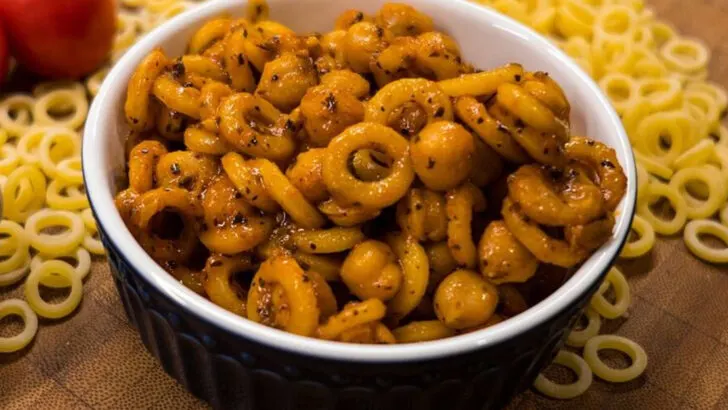Italian cuisine is known worldwide for pizza, pasta, and gelato, but what locals eat day to day tells a different story. Many traditional favorites are humble, seasonal, and deeply tied to regional culture — meals that tourists often pass over in search of the classics.
And then there are the special occasion dishes, prepared only for holidays or family gatherings, that capture the heart of Italian tradition. Together, they reveal the Italy that Italians themselves know best.
Ribollita (Tuscany)
In the heart of Tuscany, ribollita is a celebration of simplicity and depth. This hearty soup is made from leftover bread, vegetables, and beans, simmered to perfection. Its origins lie in the peasant tradition of utilizing every scrap of food.
Ribollita becomes richer with each reheating, transforming ordinary ingredients into a comforting and robust dish. The texture of the bread softens, absorbing the flavors of the broth.
Not just a meal, ribollita tells a story of resourcefulness and love for wholesome food. A perfect example of cucina povera, it nourishes both body and soul.
Frittata di Pasta (Naples)
Naples surprises with its inventive use of leftovers in the form of frittata di pasta. This dish offers a delightful twist on the typical frittata by incorporating leftover spaghetti, eggs, and cheese into a cohesive masterpiece.
Crispy on the outside and soft inside, this unique dish is enjoyed hot or at room temperature. It reflects the Neapolitan knack for turning humble ingredients into something extraordinary.
Perfect for picnics, frittata di pasta showcases the ingenuity and creativity of Italian home cooks, delivering a slice of Naples’ culinary heart.
Trippa alla Romana (Rome)
Trippa alla Romana is a dish that challenges yet rewards the adventurous eater. Slow-cooked tripe in a rich tomato sauce, flavored with mint and pecorino cheese, it’s a Roman classic.
This dish embodies the city’s culinary boldness, offering textures and flavors that intrigue the palate. Served with crusty bread, it’s a favorite among Romans who appreciate its robust and unique profile.
For those willing to step off the beaten path, trippa alla Romana provides a taste of Rome’s traditional kitchen, interwoven with history and local flair.
Panzanella (Tuscany)
Panzanella is Tuscany’s answer to a refreshing summer meal. This bread salad combines stale bread with juicy tomatoes, cucumbers, and basil, drizzled with olive oil and vinegar.
It’s a dish born from frugality, turning simple summer produce into a dish bursting with flavor. The bread absorbs the dressing, creating a delightful medley of textures.
Panzanella embodies the Tuscan spirit of celebrating seasonal ingredients and making the most of what’s available. It’s a perfect accompaniment to sunny afternoons in the Tuscan countryside.
Pasta e Ceci (Rome)
In Rome, pasta e ceci offers warmth and comfort in a bowl. This simple yet satisfying dish features pasta and chickpeas in a savory broth, often enriched with rosemary and garlic.
It’s a staple in Roman households, known for its hearty nature and nourishing qualities. The blend of pasta and legumes creates a creamy consistency that feels like a hug in a bowl.
Pasta e ceci captures the essence of Roman home cooking, emphasizing the beauty of simplicity and the comforting nature of good, honest food.
Panelle (Sicily)
Sicily presents panelle, a street food delight made from chickpea flour. These crispy fritters are seasoned with herbs and served in a soft roll, often enjoyed with a squeeze of lemon.
Panelle represents the vibrant street food culture of Sicily, offering a quick and flavorful snack on the go. The contrast of textures between the crisp exterior and soft interior is a treat for the senses.
A favorite among locals, panelle highlights the island’s culinary heritage and the simple pleasure of well-prepared street food.
Polenta (Northern Italy)
In Northern Italy, polenta stands as a symbol of rustic tradition. Made from cornmeal, it’s a versatile dish served soft or firm, often paired with hearty meats and cheeses.
Polenta’s subtle flavor acts as a canvas for rich sauces, embodying the regional love for comfort and sustenance. It provides a warm embrace during Italy’s colder months.
Celebrated for its simplicity, polenta is a staple in Northern Italian kitchens, cherished for its ability to transform a meal into a cozy, satisfying experience.
Cacciucco (Livorno, Tuscany)
Cacciucco is a Tuscan treasure from the coastal city of Livorno. This robust fish stew, brimming with seafood and flavored with garlic and pepper, captures the essence of the sea.
Its bold flavors come from a variety of fish and shellfish, simmered together to create a rich, complex broth. Served with toasted bread, cacciucco is a true taste of the Tuscan coast.
This dish reflects Livorno’s maritime culture, offering a hearty and flavorful experience that satisfies the soul and celebrates the bounty of the Mediterranean.
Supplì (Rome)
Supplì, a Roman street food favorite, entices with its crispy exterior and gooey, cheesy center. These rice croquettes, often filled with ragù and mozzarella, are a delightful snack.
In the hustle and bustle of Rome, supplì offers a quick bite that satisfies and delights. The molten mozzarella provides a surprising, satisfying pull when bitten into.
This beloved treat captures Rome’s lively street food scene, delivering a small yet mighty burst of flavor that represents the city’s culinary creativity.
Colomba di Pasqua (Easter)
Colomba di Pasqua, a symbol of Easter in Italy, is a sweet bread shaped like a dove. Similar to panettone, it is enriched with candied fruit and almonds.
This bread is a festive centerpiece on Easter tables, representing peace and renewal. Its tender crumb and sweet glaze make it a delightful treat to share with family.
Colomba di Pasqua embodies the joy and rebirth of spring, adding a touch of sweetness to the Easter celebration. It’s a culinary tradition cherished across Italy.
Panettone (Christmas)
Panettone is Christmas in Italy, a tall, dome-shaped bread filled with raisins and candied orange. Its light, airy texture makes it a holiday favorite.
This iconic bread is more than a dessert; it’s a symbol of Italian Christmas, enjoyed with family and friends. The preparation involves a long, careful process, rewarding with its rich flavors.
Panettone adds a festive spirit to the season, embodying the warmth and joy of Christmas gatherings in Italian homes. A slice of panettone is like a taste of Italian holiday cheer.
Agnello al Forno (Easter lamb)
Agnello al forno, or roasted lamb, graces Italian Easter tables with its tender and flavorful presence. The lamb is often marinated with rosemary, garlic, and lemon before roasting.
This dish symbolizes rebirth and tradition, uniting families around a shared meal. Its succulent meat and aromatic herbs create a memorable centerpiece for the celebration.
Agnello al forno highlights the simplicity and elegance of Italian culinary traditions, offering a taste of the countryside’s fresh produce and timeless recipes.
Tortellini in Brodo (Christmas, Emilia-Romagna)
Tortellini in brodo is a Christmas classic from Emilia-Romagna, where tiny pasta parcels are filled with meat and served in a rich broth. This dish warms the heart and soul.
The delicate tortellini float in a savory broth, a reflection of patience and skill in the Italian kitchen. Each bite offers a symphony of flavors that dances on the palate.
Celebrated for its elegance, tortellini in brodo encapsulates the festive spirit, bringing joy and comfort to holiday gatherings. It’s a beloved tradition, steeped in regional pride.

